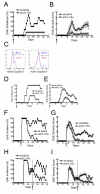Interleukin-7 is required for CD4(+) T cell activation and autoimmune neuroinflammation
- PMID: 26319414
- PMCID: PMC4658267
- DOI: 10.1016/j.clim.2015.08.007
Interleukin-7 is required for CD4(+) T cell activation and autoimmune neuroinflammation
Abstract
IL-7 is known to be vital for T cell homeostasis but has previously been presumed to be dispensable for TCR-induced activation. Here, we show that IL-7 is critical for the initial activation of CD4(+) T cells in that it provides some of the necessary early signaling components, such as activated STAT5 and Akt. Accordingly, short-term in vivo IL-7Rα blockade inhibited the activation and expansion of autoantigen-specific CD4(+) T cells and, when used to treat experimental autoimmune encephalomyelitis (EAE), prevented and ameliorated disease. Our studies demonstrate that IL-7 signaling is a prerequisite for optimal CD4(+) T cell activation and that IL-7R antagonism may be effective in treating CD4(+) T cell-mediated neuroinflammation and other autoimmune inflammatory conditions.
Keywords: EAE; IL-7; Signaling pathways; T cells.
Copyright © 2015 Elsevier Inc. All rights reserved.
Figures





Similar articles
-
IL-7Rα on CD4+ T cells is required for their survival and the pathogenesis of experimental autoimmune encephalomyelitis.J Neuroinflammation. 2024 Oct 8;21(1):253. doi: 10.1186/s12974-024-03224-2. J Neuroinflammation. 2024. PMID: 39380064 Free PMC article.
-
IL-7/IL-7 Receptor Signaling Differentially Affects Effector CD4+ T Cell Subsets Involved in Experimental Autoimmune Encephalomyelitis.J Immunol. 2015 Sep 1;195(5):1974-83. doi: 10.4049/jimmunol.1403135. Epub 2015 Jul 29. J Immunol. 2015. PMID: 26223651 Free PMC article.
-
TRAIL-Mediated Suppression of T Cell Receptor Signaling Inhibits T Cell Activation and Inflammation in Experimental Autoimmune Encephalomyelitis.Front Immunol. 2018 Jan 22;9:15. doi: 10.3389/fimmu.2018.00015. eCollection 2018. Front Immunol. 2018. PMID: 29403497 Free PMC article.
-
Regulatory T cells in spontaneous autoimmune encephalomyelitis.Immunol Rev. 2001 Aug;182:122-34. doi: 10.1034/j.1600-065x.2001.1820110.x. Immunol Rev. 2001. PMID: 11722629 Review.
-
Interleukin-2, Interleukin-7, T cell-mediated autoimmunity, and N-glycosylation.Ann N Y Acad Sci. 2012 Apr;1253:49-57. doi: 10.1111/j.1749-6632.2011.06391.x. Epub 2012 Jan 30. Ann N Y Acad Sci. 2012. PMID: 22288682 Free PMC article. Review.
Cited by
-
rhIL-7-hyFc, a long-acting interleukin-7, improves efficacy of CAR-T cell therapy in solid tumors.J Immunother Cancer. 2024 Jul 23;12(7):e008989. doi: 10.1136/jitc-2024-008989. J Immunother Cancer. 2024. PMID: 39043602 Free PMC article.
-
IL-7Rα on CD4+ T cells is required for their survival and the pathogenesis of experimental autoimmune encephalomyelitis.J Neuroinflammation. 2024 Oct 8;21(1):253. doi: 10.1186/s12974-024-03224-2. J Neuroinflammation. 2024. PMID: 39380064 Free PMC article.
-
Model-Based Characterization of the Pharmacokinetics, Target Engagement Biomarkers, and Immunomodulatory Activity of PF-06342674, a Humanized mAb Against IL-7 Receptor-α, in Adults with Type 1 Diabetes.AAPS J. 2020 Jan 3;22(2):23. doi: 10.1208/s12248-019-0401-3. AAPS J. 2020. PMID: 31900603 Free PMC article. Clinical Trial.
-
Sex-Specific Microglial Activation and SARS-CoV-2 Receptor Expression Induced by Chronic Unpredictable Stress.Front Cell Neurosci. 2021 Nov 24;15:750373. doi: 10.3389/fncel.2021.750373. eCollection 2021. Front Cell Neurosci. 2021. PMID: 34899189 Free PMC article.
-
Down-regulation of interleukin 7 receptor (IL-7R) contributes to central nervous system demyelination.Oncotarget. 2017 Apr 25;8(17):28395-28407. doi: 10.18632/oncotarget.16081. Oncotarget. 2017. PMID: 28415697 Free PMC article.
References
Publication types
MeSH terms
Substances
Grants and funding
LinkOut - more resources
Full Text Sources
Other Literature Sources
Molecular Biology Databases
Research Materials
Miscellaneous

